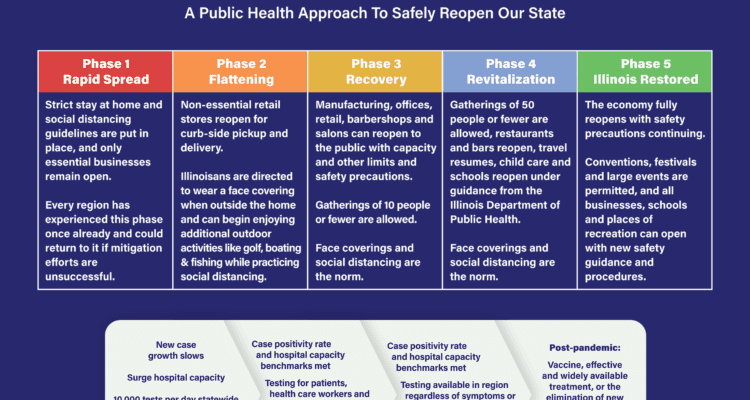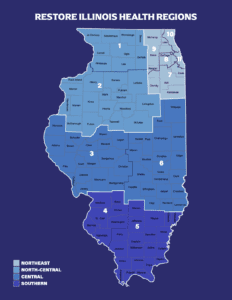Restore Illinois
Governor J.B. Pritzker announced a plan to “Restore Illinois” and reopen the state.
Restore Illinois is a five-phase plan focused on saving lives, livelihood, and safely reopening Illinois based on data, science, guidance from the Illinois Department of Public Health (IDPH), and after consulting with stakeholders across the state.
 State Broken Into Four Regions
State Broken Into Four Regions
The plan provides a framework for reopening businesses, education, and recreational activities in each phase. It separates our state into four regions: Northeast Illinois, North Central Illinois, Central Illinois, and Southern Illinois. As a region meets certain criteria, they can progress to the next phase – so that different regions may progress at different times.
“We have to figure out how to live with COVID-19 until it can be vanquished, and to do so in a way that best supports our residents’ health and our healthcare systems, and saves the most lives,”said Governor Pritzker. “Restore Illinois is a public health plan to safely reintroduce the parts of our lives that have been put on hold in our fight against COVID-19. This is also a data-driven plan that operates on a region-by-region basis, a recognition that reality on the ground looks different in different areas of our state.”
Five-Phase Plan
Here are the five phases. Our entire state is currently in Phase 2. Governor Pritzker says the earliest a region could possibly move to Phase 3 is May 29.
- Phase 1 – Rapid Spread:
- The rate of infection among those tested and the number of patients admitted to the hospital is high or rapidly increasing.
- Strict stay at home and social distancing guidelines are put in place and only essential businesses may stay open.
- Phase 2 – Flattening:
- The rate of infection among those tested and the number of patients admitted to the hospital and needing ICU beds increases at a slower rate, moving toward a flat and downward trajectory.
- Non-essential retail stores can reopen for curbside pickup and delivery.
- Residents must wear a face covering when outside and can start to enjoy outdoor activities including golf, boating, and fishing while practicing social distancing.
- Drive-in theaters can reopen.
- To varying degrees, every region is experiencing flattening as of early May.
- Phase 3 – Recovery:
- The rate of infection among those tested and the number of patients admitted to the hospital and needing ICU beds is stable or declining.
- Manufacturing, offices, retail, barbershops, and salons can reopen to the public with certain guidelines and safety precautions in place.
- Face coverings and social distancing are still in place.
- All gatherings are limited to 10 or fewer people.
- The hope is to get to Phase 3 starting May 29.
- Phase 4 – Revitalization:
- The rate of infection among those tested and the number of patients admitted to the hospital continues to decline.
- Restaurants and bars can reopen, travel may resume, and child care and schools can reopen under guidance from the IDPH.
- Face coverings and social distancing are still in place.
- Gatherings of up to 50 people are allowed.
- Phase 5 – Illinois Restored:
- A vaccine or highly effective treatment is widely available or the elimination of any new cases over a sustained period is seen.
- The economy full reopens with safety precautions – businesses, schools, and places of recreation can open with new safety guidelines and procedures.
- All conventions, festivals, concerts, and other large events are on hold until the state reaches Phase 5.
Restore Illinois Plan May Change
This plan will be updated as research and science develop.
It might be possible that one or all the regions may need to go back to a prior phase. For example, if Central Illinois makes it to Phase 4, but the research and science shows that COVID-19 cases start to increase again, the region would go back to Phase 1 or 2.
IDPH will be closely monitoring key metrics to immediately identify new growth in cases and hospitalizations to determine whether a return to a prior phase is needed.
Right now the stay at home order is still in effect and face coverings are required.
Naperville News 17’s Aysha Ashley Househ reports.









